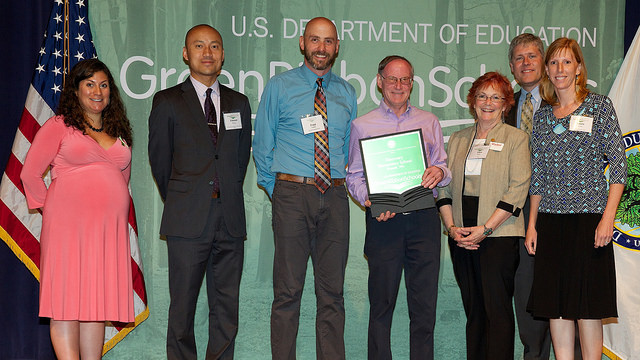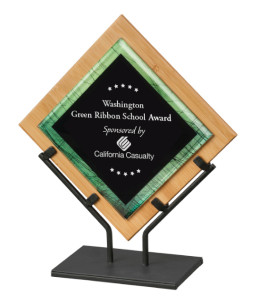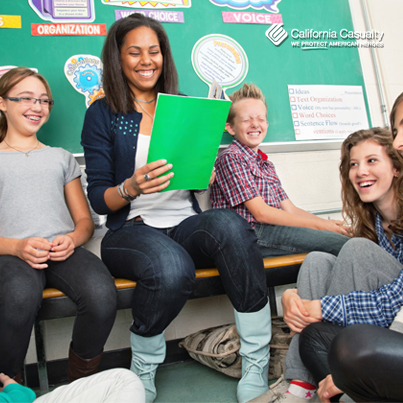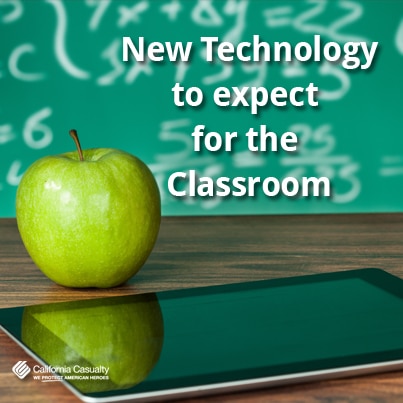by California Casualty | Educators |
School may be out for summer, but it’s not necessarily vacation time for educators. Sure, who wouldn’t want three months to relax and catch a break? Unfortunately for many, that isn’t the case. The Gates Foundation finds that about a third of teachers across the U.S. will participate in training or professional development over the summer.
If teachers are not training, many others are working a second job. Most teachers are contracted and paid for the months that school is in session, so the summer means unemployment. U.S. News says that the average teacher’s earnings, including any money made during the summer, is still lower than other professionals.
Since educators are wrapping up classes and heading into summer, we have some ideas to help beat the summertime blues.
- Eat Healthier: Don’t get sucked into comfort foods. Eat more fruits and veggies.
- Exercise: Go for a walk. Do yoga. Take a class. Even if it is small, it will release endorphins and help clear your mind, ready for focus.
- Do something for yourself every day: Enjoy playing an instrument? Or writing a blog? Either way, take a small time-out and do the thing that you love.
- Connect with others: Join conversations on social media that spark your interest, find a book club and spend time with family and friends.
As a teacher, you have more than enough on your plate. It’s time to get excited about the next three months and focus on the bigger outcome.
by California Casualty | Educators |
They work long hours supporting and educating our children. How often have you taken the time to say thank you? Here are 25 simple ways to say thanks:
- Give a sincere thank you in person
- Slip a thank you card on their desk
- Write a special note in your child’s homework folder
- Send a kind email to thank them for something specific they did for your child
- Have your child write a note or draw a picture for them
- Stop in for a brief moment before or after school to say thanks
- Tell the principal and other administrators how much you appreciate your child’s teacher
- Send in supplies for the classroom
- Volunteer in the classroom
- Chaperone a field trip
- Volunteer to help with something at home (cutting out lamination, organizing files, etc.)
- Offer to come in and help make copies or work on a special project
- Give a gift card for Teacher Appreciation Week
- Donate an iTunes gift cards so the class can download new apps
- Buy a book to donate to the class library
- Bring in homemade treats
- Deliver a cookie, or other tasty treat from a local bakery
- Find out what their favorite snack is and bring it to them
- Recognize them with some takeout for lunch
- Make a bouquet of pencils or highlighters or other school supplies
- Compliment them on Facebook
- Bring in their favorite soft drink or tea
- Give them flowers
- Buy a gift certificate they can use at a bookstore
- Help with stress; bring a relaxing gift – bath salts, soothing lotions or gift certificate for a pedicure
Here’s another way to show appreciation for a teacher that made a difference in you or your child’s life; join the National Teachers Hall of Fame’s (NTHF) “One In A Million – Teachers Who Make A Difference” campaign. Anyone in the U.S. can place a teacher’s name into the Hall of Fame archives with a $1 donation. Donations of $125 will also get the teacher’s name placed on a brick of the NTHF donor’s wall of fame. Learn more about honoring a teacher at https://www.nthf.org/honor-an-educator.
California Casualty appreciates educators. Our relationship spans 65 years. We thank them with numerous giving programs that make a real difference:
California Casualty auto and home insurance is also specifically tailored for educator’s lifestyle with exclusive benefits not available to the general public:
- $500 personal property coverage for items stolen, damaged or destroyed in your vehicle
- Reduced or zero deductible for vandalism or damage to your vehicle when it is parked at work
- Rates guaranteed for a full year (not six months)
- Free identity theft protection with each policy
- Multiple payment options including EZ Pay and holiday or summer skips
- Superior customer service – 99 percent with a claims satisfaction rating of 96 percent, https://www.calcas.com/customer-feedback
Resources for this article:
https://whattheteacherwants.blogspot.com/2014/11/25-ways-to-thank-teacher.html
https://teaching.about.com/od/ParentalInvolvement/fl/Twenty-Five-Ways-to-Say-Thank-You-to-Teachers.htm
by California Casualty | Educators |
Going green is not just a slogan for some Washington State schools. They are doing their part to teach our children life-long lessons about sustainability and stewardship of the environment.
“Kids are very creative and once we get them involved, they carry the concept even further than we imagined,” said Laurie James, coordinator of the Green Ribbon Schools project at Discovery Elementary School in Everett, Washington. Discovery Elementary is a 2015 National Green Ribbon Schools honoree.
The U.S. Department of Education urges schools and school districts across the nation to build sustainable programs using three key pillars:
- Reduce environmental impacts and costs
- Improve the health and wellness of schools, students and staff
- Provide environmental education, which teaches many disciplines, especially in incorporating STEM, civic skills and green career pathways
Answering the challenge has resulted in schools that have reduced operating costs, which enabled administrators to dedicate more resources to instruction. It also promotes more student engagement and staff pride and productivity.

Discovery Elementary now has recycling and composting bins around the campus, a community garden and new fruit trees that produce a crop every year. The environmental message has been integrated into the curriculum, including health, science and math classes. Students create and build solar projects, set up bee hives, measure how much mulch and other organic material the garden will need, and learn about fresh foods and nutrition.

For Laurie James, it was more than just tackling a set of stated goals. “This has brought children from a variety of backgrounds together, building life-long lessons about sustainability and stewardship of the environment. The end result is not only children who have a new appreciation for how they can impact the future, but it also encourages family and community involvement.”
Another 2015 Washington Green Ribbon designee is Hillcrest Elementary School in Oak Harbor. Just like Discovery, the efforts at Hillcrest Elementary are student driven. There is a heavy emphasis on the garden; incorporating science, math and other curriculum. Students measure and design the best configuration for planting the gardens, and weigh, graph and calculate how much peat moss is needed to balance food scraps used in the compost bins. They also use real life marketing and accounting principles as they sell eggs from the chickens now raised at the school. Proceeds are donated to the local food bank.
Principal Paula Seaman said that being a Green Ribbon school has been a source of pride for the students and staff. “Other schools in our district are constantly visiting and working to set up a garden like ours,” she said. “We have been awarded more grants because of our designation…including $2,000 to enhance our garden. The award has united our community and students. They are committed to making Earth a better, safer and greener planet and know their contributions make a difference.”

While achieving Green Ribbon School status is a great honor, there is a missing piece to the process. Each year, schools and districts that meet the stringent criteria are honored in Washington, D.C., but can only attend if they have the funds to make the trip. For many Washington State honorees, that can be a challenge.
Attending a program honoring the hard work of students, staff and the community shouldn’t be a burden. Seeing the need, California Casualty stepped in as the 2016 local sponsor of the Washington Green Ribbon Schools program, providing some travel and lodging expenses. As a long-time partner with the NEA Member Benefits in Washington, California Casualty is committed and honored to serve educators.
“Having this financial support takes the sting out of the cost of being recognized,” said James. “It will relieve the stress of fundraising and is one less hurdle to overcome in this important process.”
California Casualty congratulates the 2016 Green Ribbon award winners announced this Earth Day: Bethel and Issaquah School Districts, Columbia Crest A-STEM Academy (Ashford), Gaiser Middle School (Vancouver) and Lakota Middle School (Federal Way). We are proud to help support a program that benefits the environment and future generations of students while highlighting the best in Washington State schools.
by California Casualty | Educators |

How do you start the first 10 minutes of your class? Roll call after the bell in the morning? Listing an agenda for what’s to come for the day, or recapping what happened the day before? What if you took an approach that was outside of the box? Imagine giving children positive feedback that might carry them through the day and help them treat others better.”
A Florida teacher is making headlines for shedding light on bullying, and teaching his students how they can make a change. During the first 10 minutes of every class, he compliments each student one-on-one as they come to the front of the class. He gives them affirming messages such as, “Everyone here loves you,” “I love having you in class,” or “You’re great at sports.”
Research show most bullying occurs in middle school (Grades 6, 7, and 8). This could leave kids with a lasting impression which might affect them later in life. Addressing the issue and involving the class in thinking positively can have a long-lasting impact
According to Education World, you need to be cautious on how to phrase positive compliments. Instead of saying “You’re excellent at…,” focus on how hard they are trying. A couple examples are: “I like watching you work so hard at learning. It means a lot to me that you don’t give up,” or “I appreciate how helpful you have been today.”
In other words, praise them for their effort, not for their expertise.
Next time your student does make a mistake, they will see your praise as being genuine, and not feel like they are not good enough. Experts say try and use compliments sparingly to reinforce activities, otherwise you may encourage a child that only works hard for praise, not for doing their best at a task.
Sources:
https://abcnews.go.com/Lifestyle/florida-teacher-starts-day-complimenting-students/story?id=35259600
https://www.bullyingstatistics.org/content/school-bullying.html
https://www.educationworld.com/a_curr/effective-praise-compliments-students.shtml
by California Casualty | Educators |

Odds are you know Amelia Earhart, Rosa Parks, Susan B. Anthony or Clara Barton. But have you heard of Elizabeth Cady Stanton, an early pioneer in the suffragette movement; Janet Rankin, the first women elected to Congress; Memphis Minnie (born Lizzie Douglas) who became one of the top blues guitarists in the 1920s, through the 1950s or Delores Huerta, who co-founded the United Farm Workers Association with Cesar Chavez.

March is National Women’s History Month, with the goal of making us more aware of the women who changed American history, business and society. However, just like the right to vote, the push for a month recognizing the accomplishments of women took many years to become reality.
The seeds of the observation began in 1979, with roots in American education system. The week of March 8, 1978 was designated as Women’s History Week by the Education Task Force of the Sonoma County (California) Commission on the Status of Women. Dozens of schools planned special events and over 100 community women participated in special presentations in classrooms. The finale of the week was a celebratory parade and program held in downtown Santa Rosa.
A year later, other communities across the U.S. joined the celebration and agreed to support an effort for a National Women’s History Week, which was formally proclaimed by President Jimmy Carter in 1980.
Departments of education in many states adopted the celebration and encouraged curriculum to support the effort. Within a few years, thousands of schools and communities were celebrating National Women’s History Week. In 1987, Congress officially designated March as National Women’s History Month. This year’s theme is “Working to Form a More Perfect Union: Honoring Women in Public Service and Government.”
Since it gained traction in schools and classrooms, California Casualty’s education guest author Alan Haskvitz has assembled this list of some of the best resources for celebrating Women’s History Month for teachers and students:
Women in history is a topic that is rich in high interest stories and Common Core related standards. Possible integrated lessons can stress diversity, art, history, science and more. Just as importantly is the fact that the stories are compelling and often show the human spirit at its best, when facing challenges that require strength of character as well as determination.
With such a diverse range of options, I like having my students share their reading and research to cover more facts and also to motivate them to read about those women they may never have heard of before. Here is a list of 100 famous women; some may not be appropriate for every grade level, but there are enough to make for some excellent compare and contrast essays. Another fun project, after the presentations and to increase interest and listening skills, is to have the students collect facts about some of these and play 20 questions to see if they can guess who the name of the woman from the clues.
https://www.angelfire.com/anime2/100import/
- Women authors who changed history
https://mikeswritingworkshop.blogspot.com/2011/03/25-female-writers-who-changed-history.html
A great story about a woman who was the first computer programmer:
https://www.biography.com/people/ada-lovelace-20825323
https://www.infoplease.com/us/military/women-history.html
- National History W omen’s Project
A list of the 2014 honorees:
https://www.nwhp.org/whm/honorees2012.php
- Pioneering Women in American Memory
A good source of primary source material:
https://www.loc.gov/teachers/classroommaterials/presentationsandactivities/presentations/women-pioneers/
- 25 Most Powerful Women of the Past Century
https://content.time.com/time/specials/packages/completelist/0,29569,2029774,00.html
- Common Core reading standards
https://www.corestandards.org/ELA-Literacy/RI/8
About the Author: Alan Haskvitz has taught for 45 years and has credentials in special education, gifted education school administration, and all core subjects. He has been inducted into the National Teachers Hall of Fame and was chosen by Reader’s Digest as a Hero in Education. Contact him at [email protected]
by California Casualty | Educators |

Wouldn’t it be nice if we could all attend the Consumer Electronics Show (CES) in Las Vegas? We could see the vendors showing off new interactive watches, the latest in cell phones, driverless cars, home WiFi based appliances and new technological wonders that can be applied in schools.
Yes, it would be nice to get super-geeked and tech-overloaded, but it’s just not practical. The second half of the year has just begun and there are classes to manage, tests to grade and new projects to challenge students.
If you are an educator, there is good news; Leila Meyer, an education tech writer went to the show. Here are the 10 Products From CES that she predicts will have the most potential to make it to the classroom:
- DAQRI Smart Helmet – designed for industrial workers, the helmet brings a mixed reality interface with the latest technology for 4D virtual reality applications that can be used in the classroom
- Kodak’s Super 8 Revival camera – designed for a new generation of video and film makers that has many applications for students and lessons, using actual film to deliver texture and vivid color, but with a digital transfer once it’s processed
- Klaxoon Cross-Device Learning Platform – Klaxoon developed a collection of tools designed to support online, interactive learning activities for any mobile device using private WiFi and Cloud storage platforms
- Samsung Galaxy TabProS – a two-in-one tablet that is small, lightweight and shareable in the classroom
- Lenovo AirClass Interactive Virtual Classroom – the name says it all, a dashboard that is accessible for teachers and students that can track a student’s engagement utilizing emotion-analyzing software
- ASUS C202 Chromebook for Education – specially designed for the abuse that comes from multiple hands in the classroom, it features wraparound rubber bumpers with reinforced corners, spill-resistant keyboard, scratch-resistant finish and shockproof solid-state drive
- Panasonic Rug Speakers – a prototype unveiled that can be built into the carpet with controllers that can direct sound toward or away from specific people with potential for libraries and informal learning spaces
- Hanvon Pentech ERT Technology – a pen that works with all-in-one touchscreen TVs, the pen uses electromagnetic resonance touch (ERT) technology that gives more accuracy and control when writing or drawing on a touchscreen display
- XYZ Steam – 3D printers specifically designed for education with applications for science, technology, engineering, arts and math (STEM) courses
- XYZmaker – 3D modeling app designed to make 3D printing technology faster and more accessible
But having and using the latest technology for technology’s sake may not get the results many educators desire. It’s important to put it into a context of learning, as the tech-instructor at Meyer Elementary School in Lexington, Michigan found out. Jeff Dahl is teaching technology through various content areas, presenting it as something purposeful, connected to learning and relevant to real-world situations. He recommends:
- Making it applicable to other class assignments
- Don’t do it alone, collaborate with other educators
- Embrace discomfort because students adapt quickly
- Apply the SAMR Model with four levels
- Substitution – technology acts as a direct tool substitute with no functional change
- Augmentation – technology acts as a direct tool substitute with functional improvement
- Modification – technology allows for significant task redesign
- Redefinition – technology allows for the creation of new tasks previously inconceivable
- Put tech integration in action
While there are many benefits to integrating new technology into the classroom, often times, the cost is out of reach for many school districts. That’s why California Casualty created the $2,500 Academic Award, to help educators purchase the materials and gadgets they need to help their students. Give your students the advantage they deserve, apply now for the California Casualty Academic Award at www.calcasacademicaward.com.
Sources for this article:
https://thejournal.com/Articles/2016/01/07/10-Products-From-CES-That-Will-Impact-the-Classroom.aspx?Page=1
https://www.edutopia.org/practice/tech-literacy-making-it-relevant-through-content-learning







